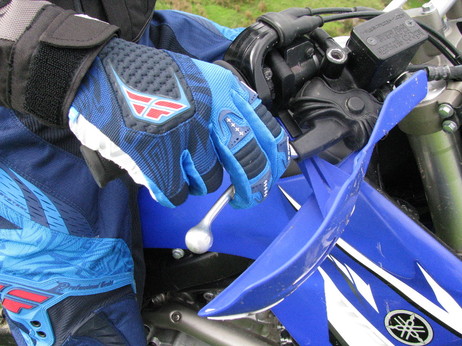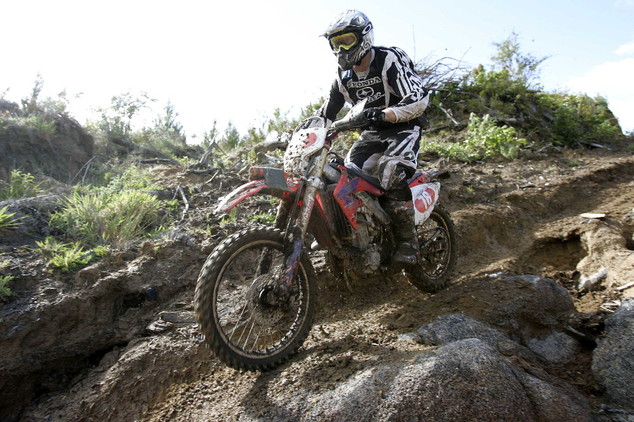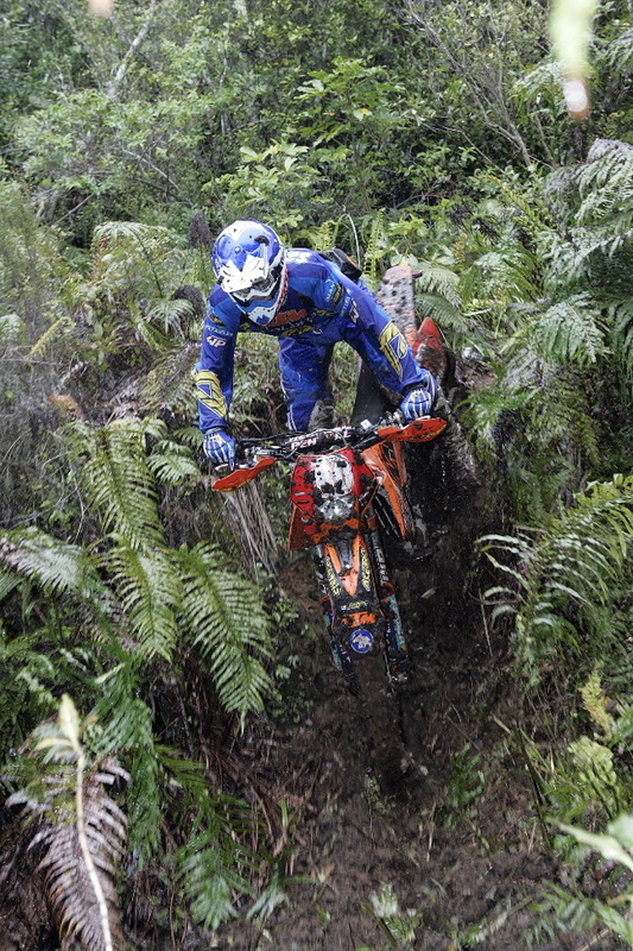GETTING THE BEST FROM YOUR BRAKES

Trail riders not only need to brake for countless corners and to descend buttock - clenching hills, but we have to combat a range of surfaces too varied to describe. Over typical Kiwi trails a rider will be on the brakes as often as they are on the throttle, so it becomes essential that braking skills are mastered and practiced.
SCARED OF YOUR BRAKES?
Most beginners find it far easier to use the rear brake. An accidental rear brake slide is easily controlled, or at worst ends in a harmless low side get off. However an uncontrolled front wheel lock-up is difficult to recover and often ends in a nasty face plant. No wonder beginners treat the front brake with suspicion!
Friendly as the rear brake is, it’s no stopper. There’s far less grip when the back tyre is dragged over the surface, not unlike dragginng a rake towards you. Conversely, under braking the front tyre digs in, like trying to push a rake forwards, thus increasing grip. There’s another product of braking, forward weight transfer. As the bike tips forward and the forks compress weight on the front wheel increases, thus further increasing grip. At the same time the rear wheel becomes lighter, gripping even less.
In addition, the brakes on a dirt bike provide more than just stopping. The rear in particular is used as much to steer the bike under brakes and control attitude, rather than actually stop. Don’t get the idea that either brake is dominant. It’s the combination of both brakes that helps us effectively slow and steer the bike. In this article we will concentrate on slowing the bike in a straight line, leaving the more complex issues of brake - steering and attitude control to another issue.
SCARED OF YOUR BRAKES?
Most beginners find it far easier to use the rear brake. An accidental rear brake slide is easily controlled, or at worst ends in a harmless low side get off. However an uncontrolled front wheel lock-up is difficult to recover and often ends in a nasty face plant. No wonder beginners treat the front brake with suspicion!
Friendly as the rear brake is, it’s no stopper. There’s far less grip when the back tyre is dragged over the surface, not unlike dragginng a rake towards you. Conversely, under braking the front tyre digs in, like trying to push a rake forwards, thus increasing grip. There’s another product of braking, forward weight transfer. As the bike tips forward and the forks compress weight on the front wheel increases, thus further increasing grip. At the same time the rear wheel becomes lighter, gripping even less.
In addition, the brakes on a dirt bike provide more than just stopping. The rear in particular is used as much to steer the bike under brakes and control attitude, rather than actually stop. Don’t get the idea that either brake is dominant. It’s the combination of both brakes that helps us effectively slow and steer the bike. In this article we will concentrate on slowing the bike in a straight line, leaving the more complex issues of brake - steering and attitude control to another issue.
ELEVEN BRAKING TIPS

1. Observe and plan. – Observe the surface type, is it dry or wet, soft loam, grass, sticky mud, hard clay, loose stones, gravel, or a combination of surfaces? Each terrain type allows different braking technique (see sidebar). Look well ahead to plan the smoothest and most direct braking line to the corner or obstacle.
2. Brake straight and upright. Make sure the bike is pointed as straight and upright as possible and beware braking over a slippery off camber.
3. Control and weight transfer. Best braking control comes from a rear biased standing attack position, taken before beginning brake application. Get your bum well back, grip the bike with your legs and extend your arms to counteract forward weight transfer under braking.
4. Use the right grip and adjust your levers correctly. Use no more than two fingers on the front brake, preferably only one. This gives better grip and allows you to still use the throttle as required. Make sure your levers are properly adjusted. See DRD #49 for details.
5. Use both brakes. While the front brake can haul you up quickly, the rear brake is also your friend. Subtle use can help keep the bike in line, or it can be locked to step the rear out in either direction. Read more about these skills in coming issues.
6. Conditioned reflexes. Repeatedly practice braking with both front and rear brakes to the point of lock up. This has its obvious risks, but unless you find out what you can do (perhaps the hard way by falling down) you will never learn the conditioned reflex actions required to effectively modulate your brakes.
7. Modulate. Rough ground, changing surfaces and downhills will require that you modulate or vary your braking power, (see the Human ABS sidebar). Take advantage of smoother ground, or areas of better traction to brake harder, easing off where holes, camber, stones, roots, or slippery patches are present.
8. Progression. Modern disc brakes are powerful, learn to apply and release power progressively. Anticipate that weight transfer allows progressively more front brake and requires progressively less rear brake.
9. Don’t forget the clutch. – Keep your hand on the clutch lever. Four strokes especially can provide a lot of engine braking, enough to lock the rear wheel under weight transfer alone.
10. Late braking. Trail riders tend to be lazy, early brakers. Try riding a MX race to find out how late braking can be left and how much faster it is. Improving your braking skills and shortening up your braking distance makes you a faster rider and helps improve control.
11. Be prepared to accelerate. When braking over rough ground be prepared to accelerate if required to straighten the bike, and on steep down hills, to re-extend the forks and lift the front wheel.
PICK YOUR SURFACE

Soft mud. Don’t let soft mud scare you, it can provide good stopping. Use both brakes, but be prepared to modulate - its what’s underneath the mud that can catch you out.
Loamy soil. Braking heaven, your tyre knobs will penetrate, so you can apply lots of front and a fair bit of rear brake.
Grass. Braking varies greatly with the amount of grass cover, moisture and ground softness. If wet or soft, aim for a clean fresh line. Using both brakes progressively, stay upright and straight and try increasing front brake bias to drive the knobs into the turf roots. Long wet grass, or heavy clover on a firm to hard soil, can be very slippery.
Loose rocks. Keep upright using both brakes gently and pick your line to avoid the worst rocks. Bouncing sideways over rocks is not a nice option.
Gravel. Regular sized gravel, although it feels skittery, can provide good braking. Almost going to the point of lockup can dig through some gravel surfaces and create grip. Caution! This does not apply to dirt roads spread with fine pumice or quarry grit!
Clay. Braking on clay depends on surface hardness. Dry clay is hard and provides good braking, though when wet is very slippery. Wet, soft clay is more manageable when the knobs can push in.
Papa rock. Papa rock surfaces are lethally slippery when wet. Slow well before you hit papa, keep straight and upright. Best not brake, but if you must, use both brakes very, very, gently.
Wood. Country, forestry and temporary trail ride bridges are often made of wood. Treat as for papa rock when wet.
Sand. Here’s the one place where the rear brake is a stopper. Soft, dry, beach sand provides limitless braking and because the rear wheel also punches a little sand dune before it, stamping on lots of rear brake is surprisingly effective. Get your weight way back and use the front brake progressively.